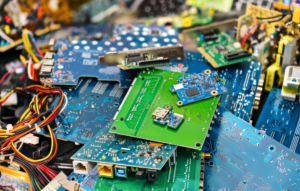
Across the current age, where technology is evolving more rapidly than ever, the world must also grapple with an unfortunate byproduct of innovation: e-waste. Millions of tons of electronic waste, everything from old smartphones to desktop computers and hand-me-down laptops have seen better days migrate between dumps every year, causing widespread pollution as well as health issues for people. Instead, there is an opportunity in this challenge. Get to know why e-waste management is no longer just dumping our trash but transforming e-waste into resources that value sustainability and saving the planet.
The E-Waste Pandemic: An Escalating Issue
Globally E-waste is the fastest growing source of Waste. This is bound to increase as technology continues its rapid advancement, and older devices soon have a replacement. This is where it gets complicated: Because of the sheer volume (and constituent toxins) of electronics, e-waste truly is an environmentalist nightmare. The downside of e-waste is enormous. Many electronics contain dangerous materials like lead, mercury, and cadmium. Which, when dumped in the wrong way can penetrate the soil and water resources leading to severe environmental degradation along with many major health problems like Asthma, Dyslexia, etc.
Important to Manage E-Waste
These threats make e-waste management essential. What this means is that these companies will take your used electronics and recycle them properly, keeping things such as bits of batteries out of the ground to prevent polluting our air, water, or soil. Although e-waste disposal is material recycling, the concept of materials management goes further: it refers to promoting an economy that recycles electronic components and substances, which minimizes demand for new resources while reducing environmental pressure.
This is one of the most important things that should be in e-waste management. Gold, silver, and copper are all precious metals that can be extracted from many electronic devices to use again. This is because 1 metric ton of circuit boards may contain up to 800 times more gold than 1 metric ton of ore, and recycling both reclaims the precious scores used in electronic products like smartphones but also helps lower environmentally damaging mining operations.
How to Manage E-Waste Properly
It will take an avalanche of donors, the business community, and help from the local government to manage this e-waste. There are a few steps key to solving the e-waste crisis:
Consumer Awareness/Education: Many people throw electronics away without considering where they go when they toss them. Believe me or not, there are a lot of them out there! This is crucial from the view that people need to understand the threat of e-waste and how it should be discarded safely. Recycling needs to be communicated but it also is little known or understood, especially when considering its value and how the process works for consumers.
EPR and Product Design: It implies that manufacturers have a significant role to play in e-waste management. Creating products that last, using recyclable materials in the creation of those products, and having take-back programs when they are discarded can all contribute to reducing e-waste. EPR policies hold manufacturers accountable for their products long past the point of sale, leading to better end-of-life practices.
Collection and Recycling Infrastructure: Efficient e-waste management is characterized by a well-established network of collection points and sorting facilities for separation and recycling processes. Facilities that can safely treat advanced electronic waste need to be built so we extract valuables while ensuring the spread of hazardous substances. However, the absence of such avenues in many places is a major stumbling block to responsible e-waste management.
Laws and regulations: Governments are required to adhere to laws that make it mandatory for the same way electronic waste is processed and recycled. Also bans illegal dumping of electronics and sets recycling practices. Second, due to the global operation of electronics manufacturing and their trade, international cooperation is vital in managing a universal e-waste issue, which may stop illegal exports of e-garbage into creating nations that frequently deal with it unsafely.
Innovation and Research: The E-waste field is vastly improvable. How e-waste recycling processes are improving with the latest technologies and raw materials being recovered for new applications Some researchers, for instance, are looking at how to recycle rare earth metals that are fundamental in electronics manufacturing but also rapidly depleting. Ongoing investment in research and development is critical to progressing e-waste management practice.
What You Can Do: Role of Individuals
Governments and the business side have a crucial role to play, but individuals can do their bit in e-waste disposal as well. Here are a few simple measures to take:
- Recycling Your Electronics:Instead of trashing old electronics, look up local e-waste recycling centers or sign on with ‘take-back’ programs from manufacturers or retailers.
- Donate or Resale:If your device is still in working condition, you can donate it to someone who needs it urgently and save lots of wasted e-waste. This, of course, translates to reducing demand for new electronic products and e-waste.
- Back Sustainable Brands:Decide on a new electronic buy one that has the essence of sustainability and encourage them to use recyclable products with programs return.
- Restrictions Upgrades:Maybe you do not require the most up-to-date device. Keeping your electronics for longer helps to lower the e-waste you produce.
Conclusion
E-waste management is not just a need; it’s an opportunity to turn around the menace of rising environmental hazards into an eco-friendly business prospect. We can recover valuable materials and reduce our burden on nature by recycling electronic components, as well as protect the earth from toxic waste. From individual efforts to corporate responsibility as well as governmental policy, there is a lot that we can do and need to be done in converting tech trash into green treasure.










